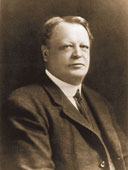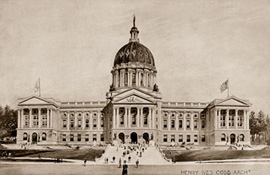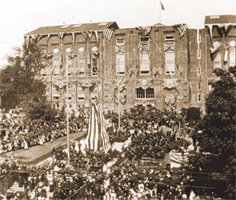Henry Ives CobbIn 1897 the Legislature appropriated $500,000 and held a design competition for the new Capitol building. Open to all American artists, the competition produced thirty-one total entries, twenty-eight of which were accepted and judged. Notable participants included Henry Ives Cobb of Chicago whose design won the competition and Joseph M. Huston of Philadelphia along with the firms of Harding & Gooch of New York City, Peabody & Stearns of Boston and Philadelphia firms Baker & Dallett and Furness, Evans & Co. A native of Brookline, Massachusetts, Cobb graduated from Lawrence Scientific School at Harvard University and then studied abroad in 1870. On his return to the U.S., he began his career working for the Boston architectural firm, Peabody & Stearns. While employed there he entered a design in the competition for a new Union Club in Chicago, and having won the commission, moved to Chicago where his firm received a number of prominent commissions, including the Federal Building and campus buildings for the University of Chicago. Though Cobb's renderings and designs depicted an amazingly ornamented and completed main Capitol building, the reality of what he was forced to provide was far from his intended vision. The "completed" structure, if it could be called that, did not include north or south transverse wings paralleling the center one, or even a dome. Instead, there was a wooden trussed roof that was covered with boards, tarred felt, and gravel. Cobb viewed his structure as a significant beginning to his grand scheme for an entire campus of government buildings, and though he took much of the blame, he could do little more with the strict adherence to funding imposed upon him. The legislature was able to meet in the "finished" structure, though the roof leaked and the ornamentation was lacking. It was not what they or the citizens of the Commonwealth had expected. However, Cobb expected to be given every opportunity to finish the construction of his proposed Capitol building in line with his original plans, just as soon as subsequent budgets were passed. Unfortunately for Cobb, 1899 brought a new administration and new members of the Assembly to Harrisburg, all with differing opinions about how to finish what was already started. Despite his desire to finish his building, the politics of the time dictated that Henry Ives Cobb would not be included in the upcoming commission. The Cobb Capitol did, however, serve an important purpose by allowing the seat of government to remain in Harrisburg. In fact, the issue of moving the seat of government may have been the impetus for action to finish the Capitol building. In 1901, with no legislation having been enacted to finish the Cobb building, Representative Charles E. Voorhees proposed a bill to move the capital back to Philadelphia. Once again, this measure was debated at great length, and various riders and provisions were attached to the bill. In the end, however, the cost of moving the capital city and a strong feeling against returning the seat of government to Philadelphia prevailed. The bill was defeated, but only by a vote of 103 to 75. |


